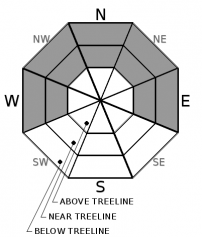| Wednesday | Wednesday Night | Thursday | |
|---|---|---|---|
| Weather: | Partly cloudy then becoming mostly cloudy. Snow levels below 7000 feet. Chance of precipitation is 0%. | Partly cloudy then becoming mostly cloudy. Slight chance of snow in the evening, then snow after midnight. Snow levels below 7000 feet. Chance of precipitation is 80%. | Cloudy. Snow in the morning, then snow likely in the afternoon. Snow levels below 7000 feet. Chance of precipitation is 100%. |
| Temperatures: | 39 to 44. deg. F. | 24 to 29. deg. F. | 28 to 33. deg. F. |
| Mid Slope Winds: | West around 10 mph increasing to 10 to 20 mph with gusts up to 30 mph by late in the afternoon. | Southwest 15 to 25 mph with gusts to 50 mph. | Southwest 15 to 25 mph with gusts up to 50 mph decreasing to west 10 to 20 mph in the afternoon. |
| Expected snowfall: | No accumulation. | SWE = none. | 80% probability 1 to 3 inches. 20% probability of 3 to 6 inches. | SWE = 0.15-0.40 inch. | 80% probability of 3 to 5 inches. 20% probability of 5 to 7 inches. | SWE = 0.25-0.50 inch. |
| Wednesday | Wednesday Night | Thursday | |
|---|---|---|---|
| Weather: | Partly cloudy then becoming mostly cloudy. Snow levels below 7000 feet. Chance of precipitation is 0%. | Partly cloudy then becoming mostly cloudy. Slight chance of snow in the evening, then snow after midnight. Snow levels below 7000 feet. Chance of precipitation is 80%. | Cloudy. Snow in the morning, then snow likely in the afternoon. Snow levels below 7000 feet. Chance of precipitation is 100%. |
| Temperatures: | 36 to 42. deg. F. | 20 to 25. deg. F. | 23 to 29. deg. F. |
| Ridge Top Winds: | West 10 to 20 mph increasing to 20 to 30 mph with gusts to 50 mph in the afternoon. | Southwest 30 to 50 mph. Gusts to 70 mph increasing to 90 mph after midnight. | Southwest 30 to 50 mph with gusts to 90 mph becoming west 15 to 25 mph with gusts to 50 mph in the afternoon. |
| Expected snowfall: | No accumulation. | SWE = none. | 80% probability of 1 to 3 inches. 20% probability of 3 to 6 inches. | SWE = up to 0.45 inch. | 80% probability of 3 to 6 inches. 20% probability of 6 to 8 inches. | SWE = 0.35-0.55 inch. |
























